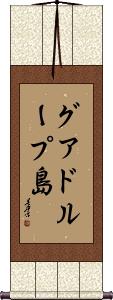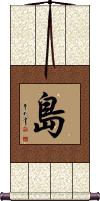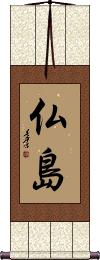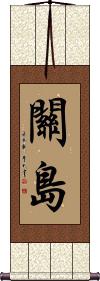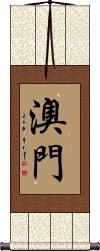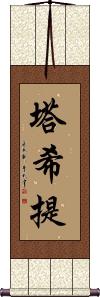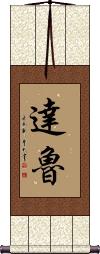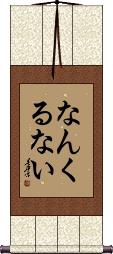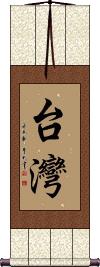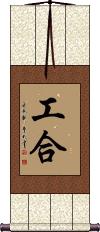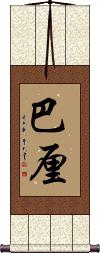Many custom options...
And formats...

Not what you want?
Try other similar-meaning words, fewer words, or just one word.
Guadeloupe Island in Chinese / Japanese...
Buy a Guadeloupe Island calligraphy wall scroll here!
Personalize your custom “Guadeloupe Island” project by clicking the button next to your favorite “Guadeloupe Island” title below...
2. Guadeloupe
4. Island
7. Guam
8. Hotokeshima
10. Macao / Macau
11. Guam
12. Macao / Macau
13. Tahiti
14. Daru
16. Taiwan
17. Gung Ho
18. Bali
Guadeloupe Island
Guadeloupe
This is the Chinese name for Guadeloupe (overseas department of France).
gua1 de2 luo2 pu3 dao3
See Also: North America
Norfolk Island
諾福克島 is the Chinese name for Norfolk Island.
Note: Sometimes written with one more character that means “ocean” making it Norfolk Ocean Island in Chinese.
See Also: Oceania
Island
島 means island in Chinese, Japanese Kanji, and old Korean Hanja.
There are a few variants of this 島 character.
嶌 is sometimes used in Japan for place names.
嶋 is another variant that used to refer to the zone or area of operation of an organized crime gang or prostitution ring.
Be careful which character you use. But
don’t
worry, we’ll only write a proper island Kanji for you.
Pitcairn Island
This is the Chinese name for the country of the Pitcairn Island (overseas territory of the United Kingdom).
See Also: Asia | United Kingdom
The Hawaiian Islands
Guam
Hotokeshima
New Caledonia
Macao / Macau
Guam
關島 is the Chinese name for the island of Guam (overseas territory of the United States).
See Also: North America
Macao / Macau
Tahiti
Daru
Don't Worry, Be Happy
なんくるない or nankurunai is an Okinawan word, written in Japanese that means “Don't worry, be happy.”
沖縄/Okinawa and/or the 琉球/Ryūkyū Islands have a more laid-back “island style” approach to life. So the nankurunai idea is a perfect match for that lifestyle.
Note: Because this title is entirely Japanese Hiragana, it should be written by a Japanese calligrapher.
Taiwan
台灣 is the Chinese name for the Republic of China which is more commonly known as Taiwan.
The island of Taiwan is actually considered a renegade province of mainland China. It became the last holdout of the former government of China after Chairman Mao took power during the revolution that followed WWII.
Note: There are a few ways to write Taiwan: 台湾 / 薹灣 / 台灣.
If you need a certain version, just let me know in the "Special Instructions" tab when you order.
See Also: Asia
Gung Ho
Working Together
工合 is one of those Asian words that is used more in English than in the original Chinese.
Gung Ho was originally used to speak of Carlson's Raiders, a group of “Gung Ho” U.S. Marines who went on an island-hopping campaign of death during WWII.
A movie called Gung Ho came out in the mid-1940s and was later re-released in the 1950s depicting the 2nd Marine Raider Battalion, and brought this word to the mainstream.
It is still sometimes used today within the U.S. Marine Corps brotherhood to refer to a unit or group that works well together or is otherwise efficient and motivated (has good morals).
In 1986, there was a movie called Gung Ho about a Japanese company taking over an American automotive factory. They completely ignored the fact that this was a Chinese title.
It should be noted that this title actually means a condition, state, manner, or the health of something in Japanese.
Language and pronunciation notes:
Like many Asian words absorbed into common use in English, this one is drastically mispronounced. The official Romanization is “gong he” but that doesn't tell you enough. The vowel sound on the first character is like the English word “own,” now just add the g-sounds to the beginning and end. The second character is misleading, as you might think it is like the English word “he.” In reality, the vowel sound is more like the “u” in “up.”
It should also be noted that the current generation in China no longer uses or recognizes this as a common word or slogan.
Note: This can be pronounced and is a word in Japanese, though seldom used. Japanese will use a variation of "具合" instead. But still, not common.
Bali
Island province of Indonesia
The Hawaiian Islands
The following table may be helpful for those studying Chinese or Japanese...
| Title | Characters | Romaji (Romanized Japanese) | Various forms of Romanized Chinese | |
| Guadeloupe Island | グアドループ島 | guadoruuputou guadoruputo | ||
| Guadeloupe | 瓜德羅普島 瓜德罗普岛 | guā dé luō pǔ dǎo gua1 de2 luo1 pu3 dao3 gua de luo pu dao guadeluopudao | kua te lo p`u tao kuateloputao kua te lo pu tao |
|
| Norfolk Island | 諾福克島 诺福克岛 | nuò fú kè dǎo nuo4 fu2 ke4 dao3 nuo fu ke dao nuofukedao | no fu k`o tao nofukotao no fu ko tao |
|
| Island | 島 岛 | tou / to | dǎo / dao3 / dao | tao |
| Pitcairn Island | 皮特克恩島 皮特克恩岛 | pí tè kè ēn dǎo pi2 te4 ke4 en1 dao3 pi te ke en dao pitekeendao | p`i t`e k`o en tao pitekoentao pi te ko en tao |
|
| The Hawaiian Islands | 夏威夷島 夏威夷岛 | xià wēi yí dǎo xia4 wei1 yi2 dao3 xia wei yi dao xiaweiyidao | hsia wei i tao hsiaweiitao |
|
| Guam | グアム | guamu | ||
| Hotokeshima | 仏島 | hotoke shima hotokeshima | ||
| New Caledonia | ニューカレドニア島 | nyuukaredoniatou nyukaredoniato | ||
| Macao Macau | マカオ | makao | ||
| Guam | 關島 关岛 | guān dǎo / guan1 dao3 / guan dao / guandao | kuan tao / kuantao | |
| Macao Macau | 澳門 澳门 | ào mén / ao4 men2 / ao men / aomen | ||
| Tahiti | 塔希提 | tǎ xī tí ta3 xi1 ti2 ta xi ti taxiti | t`a hsi t`i tahsiti ta hsi ti |
|
| Daru | 達魯 | dá lǔ / da2 lu3 / da lu / dalu | ta lu / talu | |
| Don't Worry, Be Happy | なんくるない | nan ku ru nai nankurunai | ||
| Taiwan | 台湾 / 薹灣 / 台灣 台湾 | tai wan / taiwan | tái wān / tai2 wan1 / tai wan / taiwan | t`ai wan / taiwan / tai wan |
| Gung Ho | 工合 | guai | gōng hé / gong1 he2 / gong he / gonghe | kung ho / kungho |
| Bali | 巴厘 / 峇里 巴厘 | bā lí / ba1 li2 / ba li / bali | pa li / pali | |
| The Hawaiian Islands | ハワイ諸島 | hawaishotou hawaishoto | ||
| In some entries above you will see that characters have different versions above and below a line. In these cases, the characters above the line are Traditional Chinese, while the ones below are Simplified Chinese. | ||||
Successful Chinese Character and Japanese Kanji calligraphy searches within the last few hours...
